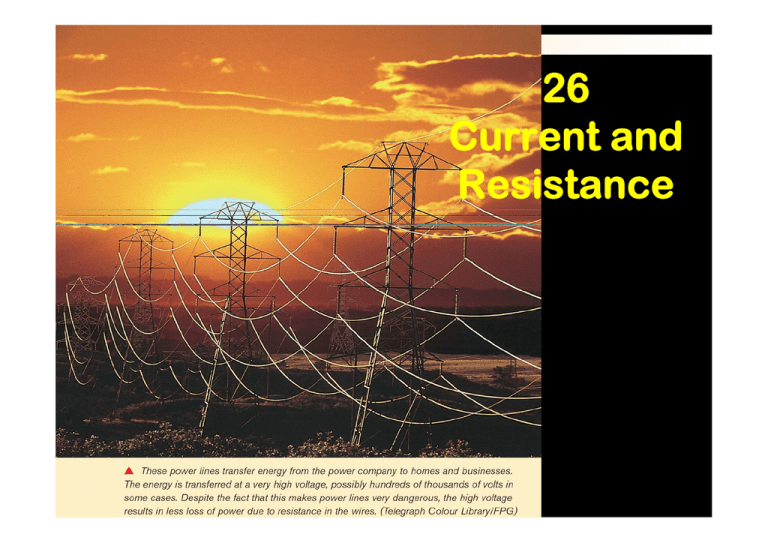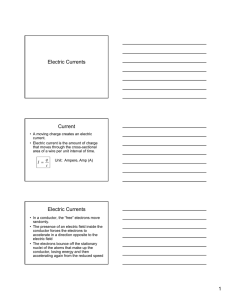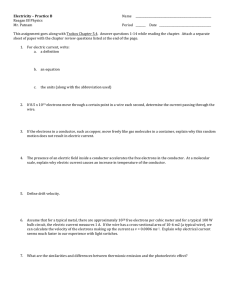Document
advertisement

26 Current and Resistance 1 Last five chapters — electrostatics (靜電學) — physics of charges in stationary state. This and the next chapter — physics of electric currents — charges in motion. Any isolated conducting loop — regardless of whether it has an excess charge — is all at the same potential. No electric field can exist within it or along (parallel to) its surface. Although conduction electrons are available, no net electric force acts on them and thus there is no current. 2 If we insert a battery in the loop, the conducting loop is no longer at a single potential. Electric fields act inside the material making up the loop, exerting forces on the conduction electrons, causing them to move and thus establishing a current i. After a very short time, the electron flow reaches a constant value and the current is in its steady state (not vary with time). Electric field 3 3 a’ dq in dt a If charge dq passes through a hypothetical plane (aa’) in time dt, then the current i through that plane is defined as (每秒通過幾庫倫) We can find the charge that passes through the plane in a time interval extending from 0 to t by integration: in which the current i may vary with time, that is i=i(t). 4 4 Under steady-state (穩流) conditions, the current is the same for planes aa’, bb’, and cc’ and indeed for all planes that pass completely through the conductor, no matter what their location or orientation. ¨ This follows from the fact that charge is conserved (電荷守恒). The SI unit for current is the coulomb per second, or the ampere (A), which is an SI base unit: 1 ampere = 1 A = 1 coulomb per second = 1 C/s. 5 5 [下圖] A conductor with current i0 splitting (分開) at a junction a into two branches i1 & i2. Because charge is conserved, i0 = i1 + i2. The relation is true at junction a no matter what the orientation and bending in space of the three wires. Currents are scalars, not vectors. (electrons) 6 Sometimes we are interested in the current i in a particular conductor. At other times we study the flow of charge through a cross section of the conductor at a particular point. To describe this flow, we can use the current density J (電流密度), which has the same direction as the velocity of the moving charges if they are positive and the opposite direction if they are negative. 7 7 For each area element of the cross section, the magnitude J is equal to the current per unit area through that area element. We can write the amount of current through the element as J⋅dA, where dA is the area vector of the element, perpendicular to the area element. The total current through the surface S is then dA S J(x,y,z) S If the current is uniform across the surface and parallel to dA, then J is also uniform and parallel to dA. Then Eq. 26-4 becomes 8 8 Because charge is conserved during the transition, the amount of charge and thus the amount of current cannot change. However, the current density does change — it is greater in the narrower conductor. A1 A2 i1=i2 J1=i1/A1<J2=i2/A2 J2 J1 9 9 Microscopic Model of Current & Drift Speed When a conductor does not have a cu rre n t through it (無外加電場), its conduction electrons (free) move randomly, with no net motion in any direction. E When the conductor does have a current through it (有外 加電場), these electrons actually still move randomly, but now they tend to drift with a drift speed vd in the direction opposite that of the applied electric field that causes the current. The drift speed is tiny compared with the speeds in the random motion [vrandom>>vd]. <ex> In copper wiring, vd of the e- is 10-4~10-5 m/s, whereas vrandom is around 106 m/s. 10 10 <Example> Positive charge carriers drift at speed vd in the direction of the applied E (不考慮熱動能造成的凌亂 運動) A The number of free charge carriers in a length L of the wire is nAL, where n is the number of carriers per unit volume. The total charge of the carriers, each with charge e, is then q=(nAL)e. 11 11 Because the carriers all move along the wire with speed vd , this total charge moves through any cross section of the wire in the time interval t=L/vd is the current i Due to J = i/A, thus ne is carrier charge density. For positive (negative) carriers, ne is positive (negative) and J & vd have the same (opposite) direction. 12 12 13 14 15 16 17 18 (電阻與電阻率) If we apply same potential difference between the ends of geometrically similar rods of copper and of glass, the currents with different magnitudes result. v icopper iglass ¨ Due to different electrical resistance. ¨ We determine the resistance (電阻) between any two points of a conductor by applying a potential difference V between those points and measuring the current i that results. The resistance R is then defined 19 19 The SI unit for resistance is the volt per ampere. This combination occurs so often that we give it the ohm (symbol Ω) A conductor whose function in a circuit is to provide the current a specified resistance is called a resistor(電阻 器). In a circuit diagram, we represent a resistor and a resistance with the symbol (如右圖). 20 20 From i=V/R, we see that “resistance” is aptly (適切地) named. For a given potential difference, the greater the resistance (to current), the smaller the current. (電阻:電 流阻力,阻力↑電流↓) We often wish to take a general view and deal not with particular objects (物體) but with materials (物質). ¨ We do so by focusing not on the V across a particular resistor but on the E at a point in a resistive material. Instead of dealing with the current i through the overall resistor, we deal with the current density J at the point in question. Instead of the resistance R of an object, we deal with the resistivity ρ (電阻率) of material which is related to E and J by 跟材質有關,跟物體幾何條件無關 21 21 跟材質有關,跟物體幾 何條件(厚度、面積等) 無關 (不會因為物體幾 何條件不同而變化) 比較 where V=∫E•ds & i=∫J•dA 不僅跟材質有關,跟物體幾 何條件(厚度、面積等)亦有 關 (會因為物體幾何條件不 同而變化) ¨ R relates to ρ & 幾何條件 22 22 23 23 We can write Eq. 26-10 in vector form as Equations 26-10 and 26-11 hold only for (electrically) isotropic materials (各方同性物質) — materials whose electrical properties are the same in all directions (ρ is a const.). We often speak of the conductivity (σ,導電率) of a material. This is simply the reciprocal of its resistivity, so The definition of σ allows us to write Eq. 26-11 as alternative form 24 24 Materials that obey Eq. 26-13 are said to follow Ohm’s law (歐姆定律). More specifically, Ohm’s law states that Materials that obey Ohm’s law and hence demonstrate this simple relationship between E and J are said to be ohmic. Experimentally, however, it is found that not all materials have this property. Materials and devices that do not obey Ohm’s law are said to be nonohmic. Ohm’s law is not a fundamental law of nature but rather an empirical relationship valid only for certain materials. 25 25 If we know the resistivity (ρ) of a substance such as copper, we can calculate the resistance (R) of a length L and a cross-sectional area A of wire made of that substance. [下圖] A: cross-sectional area of the wire, L: length of the wire, V: a potential difference exist between ends [推導] 推導 The electric field (E) and the current density (J) will have the values 26 26 Combine Eqs. 26-10 and 26-14 to write V/i ≡ R (電阻定義), which allows us to recast Eq. 26-15 as R與材質&幾何形狀有關 (R = ρ×幾何形狀參數) 27 27 Serway 同軸電纜 Radial current (漏電流:徑向) 28 28 29 29 利用R=ρℓ/A 30 30 31 31 32 32 The values of most physical properties vary with temperature, and resistivity is no exception. The relation between T and ρ for metals (copper:右圖) in general is f a i r l y linear over a rather broad temperature range. An empirical (以 經驗/觀察為依據的) approximation that is good enough for e n g i n e e r i n g purposes: The quantity α is called the temperature coefficient of resistivity. 33 33 Figure (b): V v.s. i for device I ¨ a straight line passing through the origin, so the ratio i/V (slope) is the same for all values of V. ¨ means that the resistance R = V/i of the device is independent of the magnitude and polarity of the applied potential difference V. 34 34 Figure (c): V v.s. i for another conducting device - device II. ¨ Current can exist in this device only when the polarity of V is p o s i t i v e a n d V> 1 . 5 V . W h e n current does exist, the relation between i and V is not linear. We distinguish between devices I and II by saying that the former obeys Ohm’s law and the latter does not. (idevice∝ Vdevice always) 35 35 The device I in Fig. (b) — which turns out to be a 1000Ω resistor — obeys Ohm’s law (linear). The device II in Fig. (c) — which is called a pn junction diode — does not obeys Ohm’s law (nonlinear). (R = const.) 36 36 Modern microelectronics — and therefore much of the character of our present technological civilization — depends almost totally on devices that do not obey Ohm’s law. Your calculator, for example, is full of them. * It is often contended (爭論) that “V = iR” iR is a statement of Ohm’s law. ¨ That is not true! This equation is just the defining equation for resistance, and it applies to all conducting devices, whether they obey Ohm’s law or not. If we measure the potential difference V across, and the current i through, any device, even a pn junction diode, we can find its resistance at that value of V as R=V/i. The essence of Ohm’s law, however, is that a plot of i versus V is linear; that is, R is independent of V. 37 37 We can express Ohm’s law in a more general way if we focus on conducting materials rather than on conducting devices. The relevant relation is then Eq. 26-11 E=ρJ, which corresponds to V=iR. (ρ=constant) All homogeneous materials, whether they are conductors like copper or semiconductors like pure silicon or silicon containing special impurities, obey Ohm’s law within some range of values of the electric field. If the field is too strong, however, there are departures from Ohm’s law in all cases. 38 38 To find out why particular materials obey Ohm’s law, we must look into the details of the conduction process at the atomic level (microscopic view). Here we consider only conduction in metals, such as copper. We base our analysis on the freeelectron model, in which we assume that the conduction electrons in the metal are free to move throughout the sample. We also assume that the electrons collide not with one another but only with atoms of the metal. The conduction electrons in a metal move randomly with a single effective speed veff. For copper, veff ≈1.6×106 m/s. atom e39 39 When we apply an electric field to a metal sample, the electrons modify their random motions slightly and drift very slowly — in a direction opposite that of the field —with an average drift speed vd. vd~5×10-7m/s (for metallic conductor)<<veff~1.6×106m/s. drift distance sd << total distance seff of random walk Gray line: a possible random path for an electron in the absence of an E-field; the electron proceeds from A to B (six collisions) Green line: when E-field is applied, the electron drifts steadily to the right, ending at B’ rather than at B. atom 40 The motion of conduction electrons in E-field is a combination of the motion due to random (隨機的、無規 則的) collisions and that due to the applied E. When we consider all the free electrons, their random motions average to zero and make no contribution to the drift speed. Thus, the drift speed is due only to the effect of the Efield on the electrons. [推導] If an electron of mass m is placed in an E-field of magnitude E, the electron will experience an acceleration “a” given by Newton’s 2nd law: 41 41 1 In the average time τ between collisions, all the electrons will acquire an average drift speed of vd=aτ (不考 慮初速). 2 Combining this result with Eq. 26-7 (J=nevd), yields where n is the number of carriers per unit volume. Comparing this with Eq. 26-11 (E=ρJ), leads to Equation 26-25 may be taken as a statement that metals obey Ohm’s law (微觀歐姆定律) → ρ is independent of E. 42 42 A battery B sets up a current i in a circuit containing an unspecified (?) conducting device. The device might be a resistor, a rechargeable (可充電) battery, a motor (馬達), or some other electrical device. There is an external conducting path between the two terminals of the battery B, and the potential differences VB set up by the battery are maintained, a steady current i is produced in the circuit, directed from terminal a to b. 43 43 1 The charge dq moves from a to b through a decrease in potential of magnitude V, and thus its electric potential energy decreases in magnitude by the amount dq V 2 The principle of conservation of energy tells us that the decrease in electric potential energy from a to b is accompanied by a transfer of energy to some other form. The power P associated with that transfer is the rate of transfer dU/dt = idtV/dt, which is 44 44 3 Moreover, this power P is also the rate at which energy is transferred from the battery to the unspecified device. dq V If that device is a motor connected to a mechanical load, the energy is transferred as work done on the load. If the device is a storage battery that is being charged, the energy is transferred to stored chemical energy in the storage battery. If the device is a resistor, the energy is transferred to internal thermal energy, tending to increase the resistor’s temperature. 45 45 4 For a resistor or some other device with resistance R, we can substitute Eq. 26-8 (R=V/i) into Eq. 26-26 to obtain, for the rate of electrical energy dissipation due to a resistance, either 5 Caution: We must be careful to distinguish these two equations from Eq. 26-26 and 26-27(or 26-28): (i) P=iV applies to electrical energy transfers of all kinds. (ii) P=i2R and P=V2/R apply only to the transfer of electric potential energy to thermal energy in a device with resistance. 46 46 Pure silicon has such a high resistivity that it is effectively an insulator and thus not of much direct use in microelectronic circuits. However, its resistivity can be greatly reduced in a controlled way by adding minute amounts of specific “impurity” atoms in a process called doping (摻雜). (Table 26-1) 47 47 We can roughly explain the differences in resistivity (and thus in conductivity) between semiconductors, insulators, and metallic conductors in terms of the energies of their electrons. 1 In a metallic conductor There are some electrons that are only loosely (鬆散地) held in place and that require only little energy to become free. Thermal energy can supply that energy, as can an electric field applied across the conductor. The field would not only free these loosely held electrons but would also propel (推動) them along the wire; thus, the field would drive a current through the conductor. 48 48 49 49 2 In an insulator Significantly greater energy is required to free electrons so they can move through the material. Thermal energy cannot supply enough energy, and neither can any reasonable electric field applied to the insulator. Thus, no electrons are available to move through the insulator, and hence no current occurs even with an applied electric field. 3 In a semiconductor Being like an insulator except that the energy required to free some electrons is not quite so great. More important, doping can supply excess electrons or positive charge carriers (holes) that are very loosely held within the material and thus are easy to get moving. By controlling the doping of a semiconductor, we can control the density of charge carriers that can participate in a current and thereby can control some of its electrical properties. 50 50 Most semiconducting devices, such as transistors (電晶體) and junction diodes (接面二極體), are fabricated by the selective doping of different regions of the silicon with impurity atoms of different kinds. 51 51 蹄 R=4 kΩ R=4 kΩ I=100 kA D=60 m 52 52 45 53 53 24-18 VD+Δr – VD = 54 54 55 55 不由自主 56 56 57 57 Homeworks Ans: 9.81×105 Ω 58 Ans: (a) 3.24×10-12 A/m2 (b) 1.73 cm/s 59 Ans: 0.27 m/s 60 Ans: (a) 9.20×10-4 A (b) 1.08×104 A/m2 61 Ans: (a) 1.33 A (b) 0.666 A (c) Ja Ans: (a) “Drifting” upward in the strip. (b) 12 eV (c) 12 eV 62 Ans: (a) 1.55mm (b) 1.22mm 63 Ans: 5.44 ×10−9 m/s 64 Ans: 0.224 m. 65 Ans: (a) 5.1 V (b) 10 V (c) 100 W (d) 20 W 66 Ans: (a) yes, the current density is uniform. (b) 398 ≈ 4.0 × 102 A/m2. 67 Ans: 0.1 V 68 Ans: 12 mW 69 Ans: 7.56 × 105 J Ans: (a) 0.43% (b) 0.0017% (c) 0.0034% (d) omitted 70






